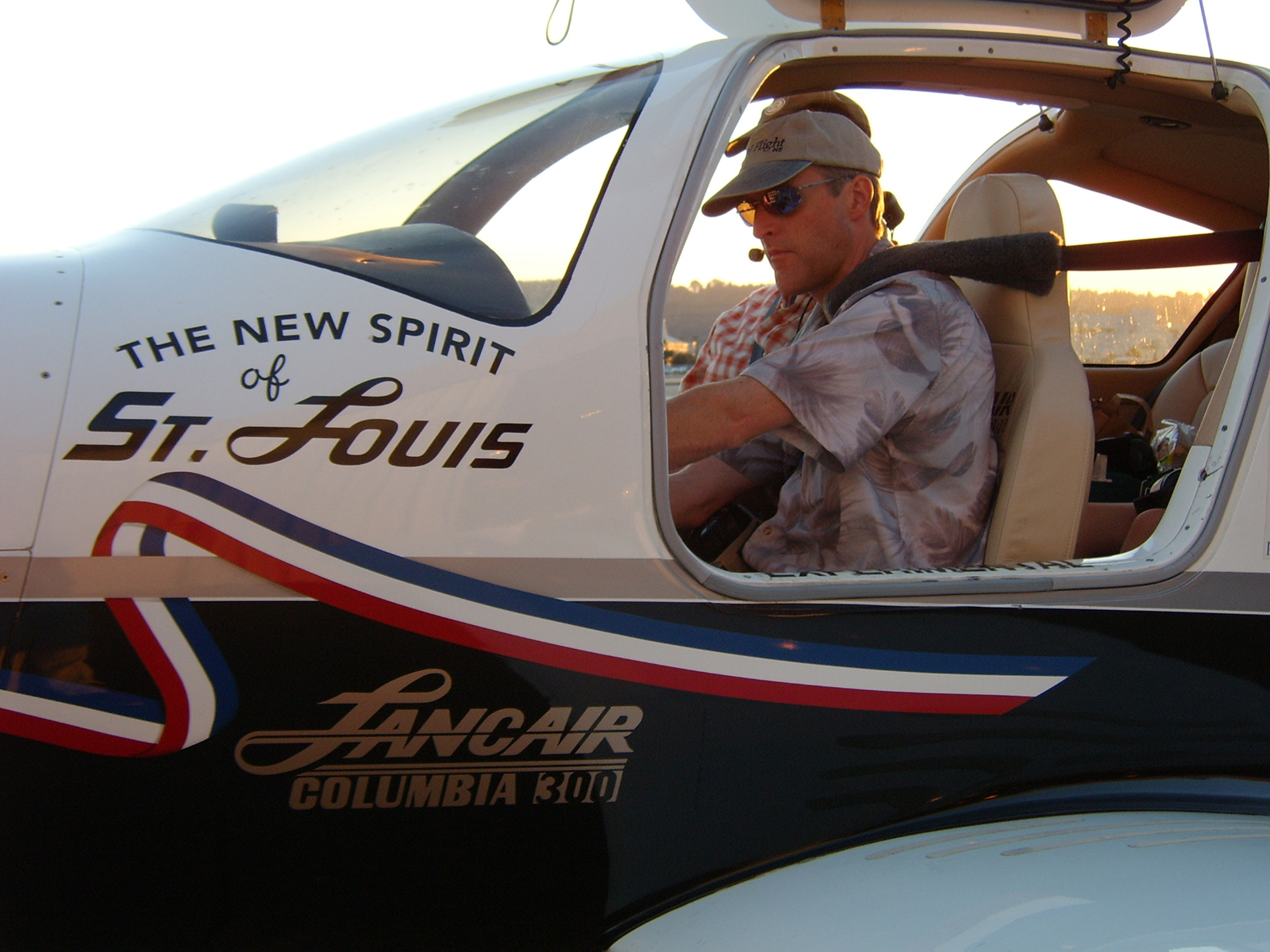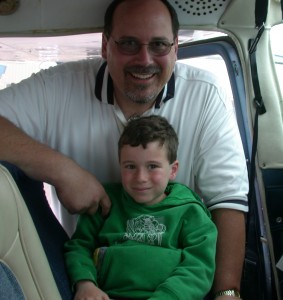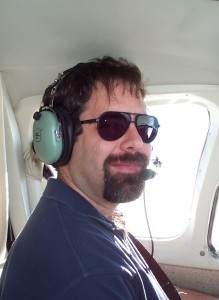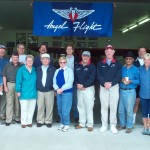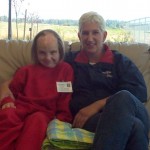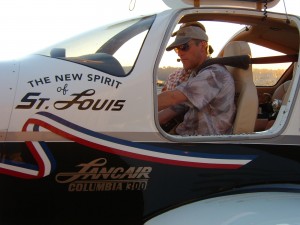
Erik Lindbergh, shown at Boeing Field, made his first Angel Flight mission, AFW mission 132539, on Aug. 19, 2006. He was flying his Lancair Columbia 300, the New Spirit of St. Louis, in which he recreated his grandfather’s crossing of the Atlantic Ocean.
By Christian Holtz
In 1996, Angel Flight’s visionary board of directors realized that most needy patients didn’t know of the organization’s existence. They embarked on an ambitious plan called Mission 1200 to double annual mission numbers by the year 2000. The board also decided to expand their own organization beyond California’s borders to other western states. At that year’s Aircraft Owners and Pilots Association Expo, held in San Jose, Calif., Angel Flight booth workers discovered that many of the pilots who had filled out inquiry cards came from Washington and Oregon. Jim Weaver, Angel Flight West’s present executive director, learned that and organized a meeting.
The following year, 20 people got together in a small meeting room at The Museum of Flight in Seattle. Their goal was to bring Angel Flight to the Pacific Northwest. Among this group would be the first Washington pilots to volunteer their time and aircraft to fulfill, in that region, Angel Flight’s mission to provide free air transportation in response to health care and other compelling needs.
“Expansion was already on our minds,” said Weaver, “After San Jose, we decided to start there.”

A Puget Sound Blood Center driver shakes Erik Lindbergh’s hand, after completion of his first Angel Flight mission. Lindbergh delivered a shipment of blood to Boeing Field.
In many respects, that meeting wasn’t so different from another that took place back in 1983, when a dozen pilots got together over coffee at a fixed base operation in Santa Monica, Calif. They were there to discuss ideas for using their planes to help others. That day, in a hangar belonging to Gunnell Aviation, at Santa Monica Municipal Airport, those pilots created the American Medical Support Flight Team, later to be known as Angel Flight. Intending AMSFT to be a national organization, they designated themselves the Los Angeles chapter.
In 1984, the chapter’s first full year in existence, volunteer pilots flew 15 missions. They fought an uphill battle, trying to convince both individuals and organizations that they could provide free air transportation to patients who couldn’t afford it otherwise. Other enthusiastic volunteer pilots soon came onboard, and mission numbers began to grow.
In California, Angel Flight yearly mission numbers reached 155 in 1989, and by 1994 leapt to 665. The annual mission total remained around 600 for the next few years.
Early days in Washington
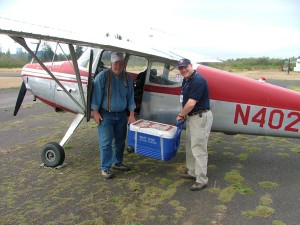
Command pilots Larry Holtz (left) and Christian Holtz (no relation) load blood from a Puget Sound Blood Center drive at Elma, Wash., into Larry’s 1948 Cessna 170. After the pilots flew the blood to Boeing Field, it was driven to PSBC’s lab in Renton.
Lorca Fitschen agreed to assume the leadership role for the Angel Flight Washington Wing. In 1997, her volunteers flew 25 of the 951 missions in Angel Flight’s western region. When Fitschen moved to Montana, starting a wing there, Gordon Brown briefly took over the Washington wing. Then, in 1998, came the husband-and-wife team of Stephen and BJ Brandli.
“Pilot sign ups in Washington snowballed at the beginning, but they really took off with BJ’s work,” Weaver said.
BJ Brandli thought it important to build an Angel Flight community.
“That’s why we started the Angel Flight Washington Wing newsletter,” she said.
She and her husband also packed their children into their plane and traveled the state to promote the organization.
“If the weather was bad, we’d load up the car,” she said. “We’d travel to a little hangar somewhere, meet with ten or twelve pilots, do our talk and collect applications.”

Christian Holtz takes off from Sequim Valley Airport in his Cessna 150, to deliver three coolers of blood to Boeing Field.
The Brandlis also sought to increase awareness through use of the public airwaves.
“We were able to get news spots on KIRO, KOMO and KING television,” said Brandli. “KING-5’s ‘Evening Magazine’ even flew with us on a mission.”
Washington-area missions were assigned out of Santa Monica. The details were faxed to Brandli, who then called pilots on her list.
“Mission coordination was from our house, using phone and fax,” said Brandli. “We didn’t have cell phones back then.”
All Angel Flight transports are confidential, and she had to destroy much of the paperwork.
“We didn’t have a shredder then, so I enlisted the kids to help me tear it up,” she said.
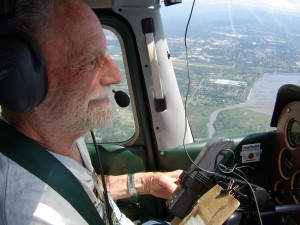
Kenneth “Larry” Gaver flew this boy and his sister home to Wenatchee from a special needs camp on Orcas Island for children on dialysis. His mission assistants, all CFIs, represent Galvin Flying, Aviation Training Center and Wings Aloft.
Her husband Stephen, a software engineer, set out to find a better way to coordinate missions. He created the Angel Flight Information Database System.
“Stephen was working on AFIDS, while I had missions spread all over the kitchen table. He donated a year of his life to Angel Flight, in order to get his wife back,” she laughed.
Angel Flight West and Angel Flight America
In early 1999, the originating California organization changed its name from Angel Flight to Angel Flight West. In 2000, Angel Flight America came into existence. AFA began as a vision of the directors of several larger Angel Flight organizations across the country. They knew more people could be helped if the separate organizations collaborated, combining their collective energies and resources. By spring 2000, seven nonprofit organizations formally combined their efforts: Angel Flight Northeast, Angel Flight Mid-Atlantic (formerly Angel Flight Virginia), Angel Flight Southeast (formerly Angel Flight Florida), Angel Flight South Central (formerly Angel Flight Texas), Angel Flight Central (formerly Wings Over Mid-America), Mercy Medical Airlift and Angel Flight West (formerly Angel Flight). Each retained its autonomy but now had a common mission and a single toll-free phone number, which would geographically route a caller to the appropriate Angel Flight regional organization.
On Sept. 20, 2000, Angel Flight West’s Mission 1200 goal was met. By the end of the year, a record 1,550 missions had been flown.
Mission numbers continued to increase in Washington as well. In 2000, that wing flew 182 missions. In 2001, the figure was 246, and by 2003, that wing flew 323 missions, becoming the first AFW wing outside of California to fly more than 300 missions in a year.
HSEATS
Following the events of Sept. 11, 2001, and the generous outpouring of volunteer pilot services, Mercy Medical Airlift was inspired to develop the Homeland Security Emergency Air Transportation System. HSEATS is designed to respond to small local or major national disasters. Within this system, Angel Flight’s volunteer pilots can elect to be “first responders” or “sustaining responders,” based on their ability and timeframe to be airborne.
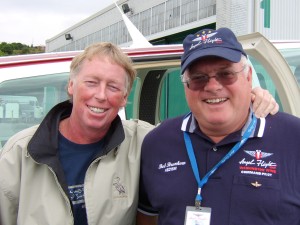
Bob Brunkow (right) transported Brad to Boeing Field from Blaine, Wash., near the Canadian border. Brad was in Seattle for radiation and chemotherapy treatments at Virginia Mason Medical Center.
Hurricane Katrina provided an opportunity to test HSEATS. After the hurricane devastated the Gulf Coast in late summer 2005, Angel Flight America flew more than 2,000 missions, moving 3,000 people. Angel Flight South Central and Angel Flight Southeast pilots flew most of the missions, but Angel Flight West, hundreds of miles to the northwest, accounted for 119.
Merger results in more pilots
At 2003 EAA AirVenture Oshkosh, Angel Flight America merged with AirLifeLine, general aviation’s only other major volunteer air transport organization in the United States. Their partnership, under the Angel Flight name, formed a larger, stronger and more efficient organization.
The merger meant 275 more pilots for Angel Flight West and an increase of more than 1,500 missions per year. The Washington wing enjoyed this influx of pilots.
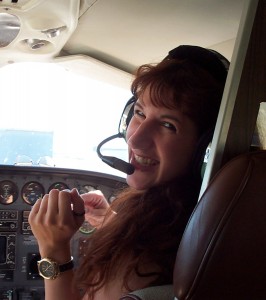
BJ Brandli, former Washington wing co-leader, assists on a mission piloted by her husband Stephen Brandli.
“It seemed like it took forever for us to get 100 pilots,” said Fred Jossy, Washington wing leader since 2001. “Suddenly, we were well above that number.”
Angel Flight West, with wings established in all 13 western states including Alaska and Hawaii, is currently flying more than 4,000 missions a year, out of Angel Flight America’s 25,000 national missions. The Washington wing flew 529 missions, its highest number yet, in 2006. Most Washington missions are within the state, often between Spokane International Airport and Seattle’s Boeing Field, but some extend as far east as Missoula, Mont., or as far south as Medford, Ore. Flights farther away may be broken into individual legs, flown by multiple pilots from different state wings.
Angel Flight West, three other regional Angel Flight organizations and Angel Flight Australia now use the Angel Flight Information Database System, created by Stephen Brandli. The Brandlis traveled to Australia to help install the system.

L to R: Children’s Hospital social worker Jane Driscoll, with Washington pilots Christian Holtz and Ann Price, after returning from a special needs camp. Driscoll coordinated the Orkilla Camp for children on dialysis.
BJ Brandli enlisted others to help with Washington pilot recruitment, healthcare outreach and mission coordination. Her team became known as the Wing Leadership Team. The Brandlis’ work on behalf of Angel Flight garnered the couple an American Red Cross Hero Award in 2000.
Just one flight makes a difference
Angel Flight pilots usually fly patients requiring specific medical treatment that can’t be supplied locally. But they also fly children to special needs camps, including camps for children who have suffered severe burns or are on dialysis. Since spring 2005, pilots of the Washington wing have flown blood from area blood drives to Seattle, for the Puget Sound Blood Center.
Pilots choose missions from a weekly emailed list or from the website. Missions are posted with travel date and time, origin and destination airports, distance, number of passengers and passenger or cargo weight.

Tim Weston flew the Washington wing’s 2000th mission, with assistant BJ Brandli (center) and Kari, who was flying to Children’s Hospital for a checkup. Kari suffered brain trauma and a fractured pelvis when a truck hit her while she was riding a scooter.
Angel Flight pilots come from all walks of life and fly everything from Cessna 150s and 172s to King Airs and Pilatuses. What unites them is a desire to give of themselves, using their unique skills and their love of flying. One Angel Flight pilot admitted that he was going to be up there flying anyway.
“It’s a way for me to be selfish and generous all at the same time,” he said.
As mission numbers continue to climb, so does the need to recruit more pilots. Though Washington now has 200 AFW command pilots, those who have completed mission orientation, Jossy noted that the “20/80 rule” seems to persist: 20 percent of the pilots fly 80 percent of the missions. Oregon wing member Rosemary Pelissier has suggested that Angel Flight begin using the slogan, “Just one flight makes a difference.” She said it would inform prospective pilots that they aren’t expected to fly a great many missions. Plus, it would ask existing Angel Flight pilots to consider flying just one more mission per year.
This year marks the Washington wing’s 10th anniversary. It’s also the second and final year of the
Spreading Our Wings campaign to raise $2 million for the Angel Flight West Foundation. Organizers hope the invested principal will generate a consistent revenue stream to support AFW’s operational budget. Funds will pay overhead expenses, such as coordinator salaries, office space leases and computer and phone system usage. To date, $1 million has already been raised.
Angel Flight West also needs more volunteers, to fly missions and for community outreach, pilot recruitment and press relations. To build camaraderie, volunteers also plan and coordinate wing events, which include a Christmas potluck and summer fly-in. To celebrate its 10th anniversary, the Washington wing is planning a summertime overnight fly-in to Walla Walla, Wash., for dinner and wine tasting.
For Washington volunteer opportunity information, contact Fred Jossy at 425-488-0203. For a list of AFW pilot requirements, visit [http://www.angelflightwest.org]. To request a mission, call Angel Flight America at 877-621-7177.
- Members of the Washington wing attend a summer fly-in and barbecue at Western Airpark, home of Tim and Myrna Weston, in Yelm, Wash.
- BJ Brandli waits with Emily in Corporate Air Center’s lobby at Skagit Regional Airport, for a van scheduled to take Emily to a summer camp on Samish Island, organized for burn victims. Marion E. Sluys, of Poulsbo, Wash., flew Emily from Hillsboro, Ore.











